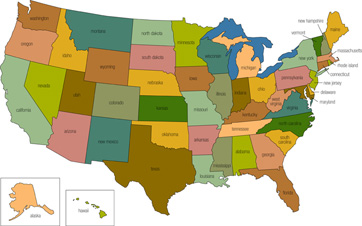Disparities in CVD burden persist among US states
Despite marked improvements in CVD burden between 1990 and 2016, large disparities remain in total CVD burden among U.S. states, according to a study published in JAMA Cardiology.
Global Burden of Disease Study
Gregory A. Roth, MD, MPH, assistant professor of cardiology at the University of Washington in Seattle, and colleagues analyzed data the Global Burden of Disease Study 2016, which included information on prevalence, incidence, risk exposure and mortality. CVD was estimated in the 10 most common global causes of CVD-related death with the addition of another category to combine other CVD and circulatory conditions.
Each state’s population counts were retrieved from the U.S. Census Bureau. Inpatient and outpatient claims data on state levels were retrieved from a database of public and private insurance schemes.
The Cause of Death Ensemble Model was used to estimate all-CV, all-cause and cause-specific mortality. Researchers also calculated disability-adjusted life-year for each age-sex-year-state-cause strata.

Age-standardized CVD DALYs decreased in all states between 1990 and 2016.
Large rises in relative rank ordering for total CVD DALYs were seen in several states, including Alabama, Alaska, Arkansas, Kentucky, Kansas, Indiana, Iowa, Missouri and Oklahoma. The rate of decline for DALYs was significant in all states, although it varied across states. Between 2010 and 2016, total CVD burden increased for men and women in the following states: Indiana, Kentucky, Michigan, Mississippi, Missouri, New Mexico and South Dakota.
The burden of CVD was twice as great in men vs. women in all states for cardiomyopathy, ischemic heart disease and aortic aneurysm. The leading cause of CVD DALYs in all states was ischemic heart disease, and it was the second most common when varied by state.
Causes of DALYs
The greatest number of DALYs was caused by dietary risk factors in almost all states, which was followed by high BMI, high systolic BP, high fasting plasma glucose level, high total cholesterol level, low levels of physical activity and tobacco smoking. There may be more unmeasured risks beyond the traditional factors, which was shown by increases in risk-deleted CVD DALY rates in 16 states between 2006 and 2016.
“These findings support the idea that tremendous gains in cardiovascular health are possible even in states with lower socioeconomic levels but that relative disparities between states have changed very little,” Roth and colleagues wrote. “These relative disparities may be of particular concern for Alabama, Mississippi, Oklahoma and Tennessee, given their recent decision to not expand their respective Medicaid systems.”

In a related editorial, Wayne D. Rosamond, PhD, MS, professor in the department of epidemiology at the University of North Carolina Gillings School of Global Public Health, wrote, “The article by the Global Burden of Cardiovascular Diseases Collaboration is a major step forward in this study and measurement of the burden and trends of CVD and may indeed provide benchmarks for regions committed to creating positive change and preventing a reversal of decades of favorable trends in CVD burden across the United States.”
Analyzing future data will become important in preventing and controlling CVD, Mark D. Huffman, MD, MPH, associate professor of preventive medicine (epidemiology) and medicine (cardiology) at Northwestern University Feinberg School of Medicine, wrote in a related editor’s note.
“How close to truth will these estimates be in 5, 10 or 15 years,” he wrote. “If not these investigators, then who will take up this complex yet crucial work of surveillance using all available data with consistent methods? Whose duty is this? These important questions will likely remain and be debated while decisions will need to be made on how best to prevent and control CVD, the leading causes of death in the United States and globally. Estimates such as these, imperfect though they are, will be important for informing such decisions now and in the future.” – by Darlene Dobkowski
Disclosures: Roth and Rosamond report no relevant financial disclosures. Huffman reports he received funding from the World Heart Federation for serving as its senior program adviser for the Emerging Leaders program, which is sponsored by Boehringer Ingelheim and Novartis, and support from AstraZeneca and Verily. Please see the study for all other authors’ relevant financial disclosures.

